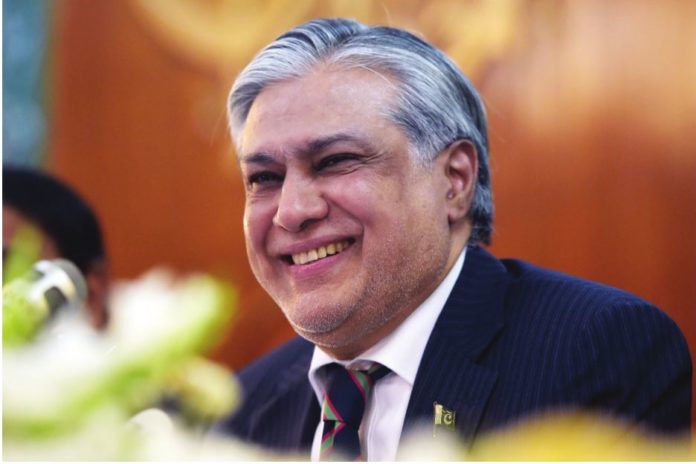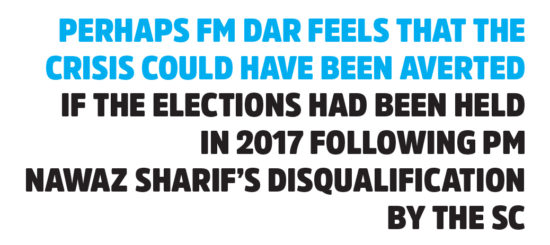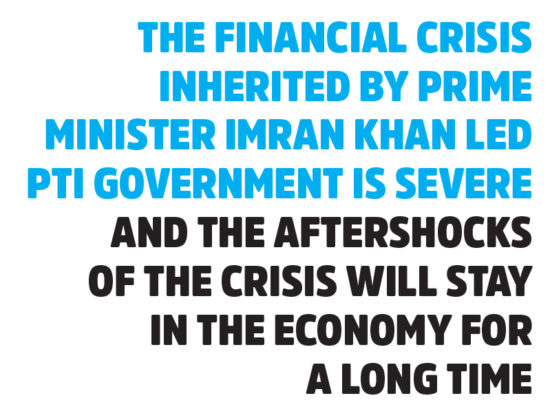
The former Finance Minister Ishaq Dar has finally come out to share his side of the story on what went wrong with the economy. This is probably the first time a former FM has taken responsibility for his government’s failures. His article published in The News on 29th October titled ‘Facts about Public Debt’ states that ‘PM Abbasi and his economic team were faced with huge unbudgeted financial demands’ in the lead up to the 2018 elections and consequently ‘economic discipline could no longer be maintained’.
The ‘huge’ financial demands could be seen in the ‘unfortunate’ build up in debt according to FM Dar. Total public debt during the year FY18 increased by a record Rs. 3.4 trillion, out of which Rs 2 trillion was foreign loans. This does not include the debt piled on by the loss-making public sector enterprises. According to FM Dar, if this slippage had not taken place in the last year of the PML-N government, the economy would not be racing towards another financial crisis.

In this narrative, poor Miftah Ismail comes out as the inexperienced, incompetent replacement FM holding the smoking gun. In particular, FM Dar took strong exception to the reversal in the key policy anchor of his regime, i.e. the USD / PKR fixed peg. Under Miftah’s regime, this policy was reversed and rupee depreciated 23% to 128 (from 104) ahead of the 25th July 2018 General Elections. The rupee depreciation added significantly to the external debt obligations as a percentage of Government revenues.
Perhaps FM Dar feels that the crisis could have been averted if the elections had been held in 2017 following PM Nawaz Sharif’s disqualification by the SC. However, it is unfair to lay the blame squarely on the shoulders of Miftah Ismail. Most independent experts had been warning about the looming financial crisis much before Miftah took office.
The financial crunch is felt most severely in three key areas of the economy. First and most severe is the Balance of Payment crisis with Pakistan running out of FX reserves to cover its imports and to pay back the external loans. The second and equally severe is the inability of the Government to fund its unsustainable fiscal spending with tax collection barely covering loan repayments and running of government. The third crisis that has resurfaced is the record losses of the Power companies and the build-up of the large circular debt in the energy supply chain.
The source of the balance of payment crisis this time around is the collapse in exports and large debt repayments due in the next one years. Under the PML-N government, exports had collapsed to $20bn by 2016, down from $25bn in 2013. This was the longest and sharpest decline in exports recorded in Pakistan’s history.
During the same time, period exports from Bangladesh jumped from $26bn to $35bn. The decline in exports was a direct result of the rising cost of doing business, with Pakistan’s ranking plummeting to 147 in 2018 (from 107 in 2013).
Alarm bells had started ringing and Dr Hafiz Pasha’s article titled ‘Balance of Payment Emergency’ in September 2017 stated that ‘SBP FX reserves are now below safe levels’ of 3 months of import cover. The gap between foreign income (exports + remittances) and the import bill was an ‘unsustainable $1bn a month’ according to Dr Pasha. In its first post-program monitoring report the IMF staff warned that SBP FX reserves (net of short-term liabilities) at the end of 2017 had declined to a negative $724 million, down from $7.5 billion at the end of the IMF program in September 2016.
This was also visible in the panic in the markets. KSE 100 index fell 29% to 37,919 points by 19th December 2017, from a peak of 52,876 points in May 2017. Urgent economic measures were needed to stabilize the economy and calm the markets. In December 2017, SBP started to raise interest rates and allow the rupee to depreciate in an attempt to reduce the rising trade deficit. This move should have been complemented by measures to contain the government’s fiscal deficit. However, unfortunately, the PML-N government was desperate to win the 2018 elections regardless of the cost to the economy. We saw a significant increase in pre-election spending that led to a record fiscal deficit of Rs2.3 trillion (6.8% of GDP) in FY18.
The third crisis on the PSEs has also become severe with the entire energy supply chain clogged due to the circular debt. During the same period as expensive new power projects set up by the PML-N government started to come online in 2017, power generation picked up but the cost of production started to escalate. With no improvement in Transmission & Distribution losses, the circular debt in the energy supply chain spiralled out of control. By end of June 2018, the circular debt had skyrocketed to Rs 1.2 trillion, compared to Rs 480 billion when the PML-N government took office in 2013.

The financial crisis inherited by Prime Minister Imran Khan-led PTI government is severe and the aftershocks of the crisis will stay in the economy for a long time. There is no one better qualified to talk of this crisis than FM Dar, whose policies have brought the economy to the edge. And this is not the first time too. His previous PML-N government of 1999 also left Pakistan in a similar mess. Back then Pakistan was forced to restructure debt (technical default) and freeze foreign currency accounts. Forward to 2018 and once again Pakistan is forced to seek extraordinary financial assistance from Saudi Arabia and other friendly countries to avoid a default.






Stopped reading that article at the point where it said rupee depreciated from 104 to 128 under Miftah’s regime. Blatant lie.
Mashallah. This species ladies and gentlemen is known as a Patwari. Found in the most common circles of Punjab and some other provinces of Pakistan. It has IQ level equal to office chair and will vote for PmlN no matter what they do to Pakistan.
You are 100% correct. Dar never says what were these financial demands, is he talking about what he and Nawaz sharif transferred out of Pakistan in their kids accounts through money laundering.
These basturds do nothing to Pakistan, they rather DO Pakistan
Here’s some currency history… Assess for your self
10 Dec: USD/PKR = 105.80
31 Dec: USD/PKR = 110.65
31 Mar: USD/PKR = 115.74
21 Jun: USD/PKR = 121.50
22 Jul: USD/PKR = 128.50
02 Aug: USD/PKR = 123.90
11 Oct: USD/PKR = 123.30
14 Oct: USD/PKR = 133.80
19 Nov: USD/PKR = 134.40
Well written but this is only side. No one in this world trust new Govt due to flow things.
1) Qatar has good business reputation but IK is blaming them for corruption & whole business world knows that IK is lying for gaining political edge.
2) Ik in new guy in international politics & his problem with US is main reason of not getting loan from anyone.
3) CPEC is biggest problem for economy but IK still have time to change the picture. IK is still blaming other things.
We lived beyond our means for several years and now is the time to face the challenge with a realistic approach and build a sustainable foundation for the future. Blaming each other will do nothing except bringing in more weakness ans chaos. Humbleness; we need…..
finencial crisis are the result of deviation from constitution extra and above and over the constitution actions by the PTI and other political parties institutions to break and shatter the PPML N and its government
Comments are closed.